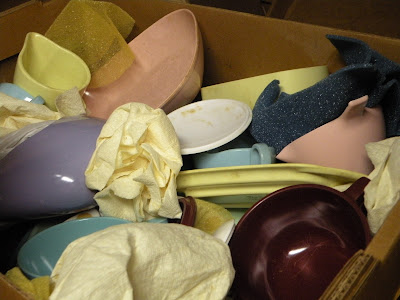The Dilemma:
 |
| Hello, what's this? Spaulding Ware Creamer in Color-Flyte Colors? |
It doesn't matter how long you collect something there will sooner or later be things that pop up that mystify you or are unexplainable. Imagine my surprise when I find
this creamer marked Spaulding Ware, Chicago, but is a dead ringer for the designer Kaye Lamoyne's "Glow Copper" color of the Branchell Color-Flyte line.
So my question was which came first, the chicken or the egg? Relatively little is known about Spaulding Ware company history, I looked in some old Modern Plastics Encyclopedias and didn't see any Spaulding listed in Chicago in the forties. I then found them listed in a 1953 Registered Corporations book of Illinois, however under "A-A Housewares, Inc." At the same address was the offices of Spaulding at 3520 N Spaulding Avenue, Chicago 18 Illinois wherein respective representatives were Harry Wohl and Dorothy Pollenz.
 |
| The original building where Spaulding Ware offices' were still stands in Chicago. |
|
|
 |
| Spaulding Ware Galore as offered in dadadish! |
Just when I thought this "glow copper" creamer dilemma could be an uncommon fluke, melmac collector Ken Whittington of North Caorlina tells me there were other colors done in the other Color-Flyte colors as well! I was baffled!
What is the Connection?
Sadly I cannot form any connection what so ever between Branchell and Spaulding, no matter how much sleuthing I do. Branchell, according to
Dennis Teepe's Branchell History site lists them in business circa 1952-1958 at which time it was sold to Lenox. Branchell's factories in St. Louis and Puerto Rico do not explain how during the same era the colors of the Color-Flyte designs would have gone to Spaulding. I believe Spaulding's dinnerware was produced elsewhere in Chicago, so definitely NOT in St. Louis!
There are of course only four possibilities that I deduce:
1)
"Maybe Laymoyne worked for Spaulding." I don't think so. Certainly he was under contract at the time and to leak a top secret formula would have been a huge no-no with legal ramifications.
2)
"Maybe Spaulding had the color first and Laymoyne bought it." Doubtful, he was a great designer.
3)
"Perhaps Spaulding acquired it after Branchell's demise." This would have meant the dishes had to be produced circa 1958 when Branchell closed. Spaulding would have had a four year window to do so, from 1958 to 1961 because they were still offering melmac in 1961 as listed in a Supermarket Merchandising Magazine under "Melco-Ware".
4)
"Perhaps they duplicated it and used it without permission with no one ever catching them." It wouldn't be the first time, I've seen examples of Residential by Russel Wright and Daileyware using the same formula, but these were also produced in the same factory. Being that ColorFlyte was produced in Missouri and Puerto Rico, this didn't seem a viable solution.
 |
| A full set of hard to find Spaulding Ware recently sold on Etsy at PomDecor's shop. |
If you look closely at the photo above the creamer and sugar would indeed be a more rigid feel. I always thought that some of the creamer and sugars like the styles above were indeed polystyrene. We will find out soon, that Spaulding was using "less melamine" in some of their pieces which would explain why the pieces in the same set may feel or look differently (and perhaps not wear as well.)
The Answers, or Not?
The more I read on Spauldingware, the more I think the latter two possibilities may indeed apply to the latter years window. In
this May 1956 ad, Life Magazine shows Capri (regular color palette) and Decorated (patterns) as the two "styles." They were also showing "Melco-Ware" at the Housewares Show in Chicago according to Modern Plastics Magazine. "Melcoware" is also traced back to their office address. I can only assume that Melco-Ware stands for (
Melamine -
CoPolymer - Dinner
ware).
Ironically, in June 1960, the Spaulding Corporation (
then containing the names of Gilbert B. Fern and the same Harry Wohl and Dorothy Pollenz from above) were being charged both as a whole and individually by the Federal Trade Commission. Essentially scamming the public as melamine co polymer did not exist, and it was in their print ads, guarantees, and advertising. By December the same year they were in huge trouble.
 |
| Guess I'll never know why or how these Spaulding Ware Spice Containers came to be. |
It's no wonder by the early 60's they were gone. No doubt legal fees and loss of production time would drive them into their ultimate demise. ~
Poof, just like that~ We may never know the beginnings or the end of this company, or half the inner workings, but I can't help to find it odd that they would go to a housewares show and brag and advertise their wares as Melamine Co polymer only to become quickly indited. Did a competitor get a whiff of this infraction and turn them in? Was this a sneaky way to avoid the inflating costs of melamine? Did they cross the line too many times and operate shadily before (hence eluding to the Colorflyte dilemma)?
I'd like to think the wide world of melmac production full of mobsters and loan sharks, because , after all, this was
Chicagoland. I guess we'll never
know.
Have information on Spaulding?
Write me!
 |
| Love me? Link me! |











 Rare Watertown Butter dishes in Olive green were found. Was this a mistake or did
Rare Watertown Butter dishes in Olive green were found. Was this a mistake or did 

